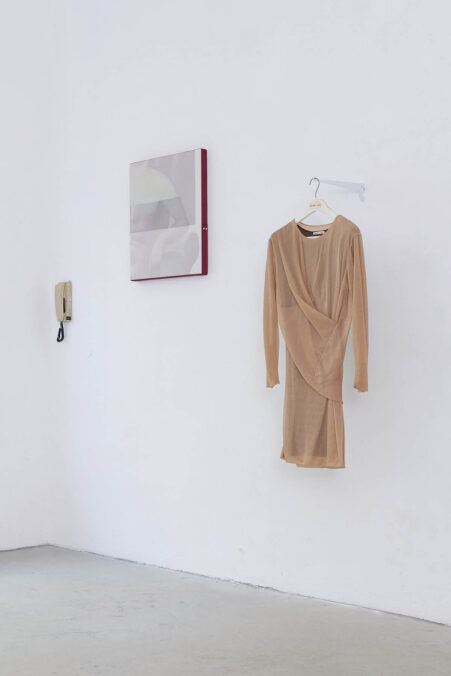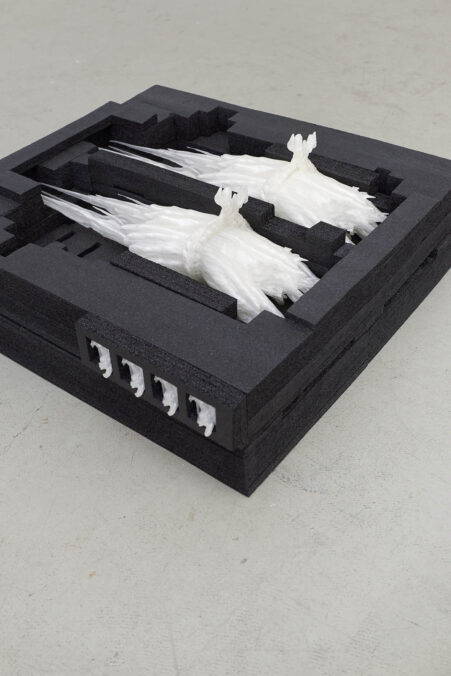
In the apartment with low ceilings, she lies in a bed that feels too big for one person. Awake, wearing just her black panties—the ones designed
and cut for men.1 Today, she’s going swimming; she needs them,
her polyester friend, in the water.
The apartment has two large rooms and a kitchen facing the backyard.
No foyer. She uses the room closest to the entrance to store her clothes that fill the shelves and hundreds of drawers. Many items hang on the walls, wrapped in small ribbons—mostly ceramics, glass pieces, and small neon signs with „constructive“ messages.2 Large, unusually shaped glasses hold plastic bouquets.
Last night, she dreamed of a dress made of gold—not solid, but fluid, fragile gold that melts over her body.



She checks herself in the mirror. She needs something over her shoulders, and there it is—a dark green crepe blazer on the chair beside her. She exits the flat and steps onto the narrow street that connects the back park entrance with the main town square. She turns left toward the sports center.
As she walks, she glimpses through a shop window at objects smoothly packed together: perhaps lamps or vases, organically shaped, milk-white, and made from a nearly transparent material. They rest in black foam boxes, contrasting with the store’s blue light.



A car approaches, and her vision blurs. She needs to sit down. The restaurant is just a few steps away, with tables covered in checkered cloths and dried brown flowers.
She sits on one of the chairs. And as she often does these days, she begins to think about the world around her. By “world,” she means objects—materially present and seemingly “still.”3 They aren’t, and they will never be, just things: they are echoes of her identity, fragments of memory, and all her longings.


Gloria Pagliani was born in Italy in 1996. She began her studies at the art academies of Venice and Bologna. Since 2019 she has been studying in Michaela Eichwald and Thomas Winkler’s painting class at the Academy of Fine Arts in Vienna. She lives and works in Vienna. Gloria’s work explores the consequences and contradictions inherent in a metapictural approach to working with images, such as impersonality, artificiality, the use of illusions, and the discussion of the distinction between decoration and ornament. She constructs her images from simple quotes to simple childhood collages, always with a subtle sense of humor.
Luis Zimmermann, born in Aachen in 1998, is a master’s student of Thomas Grünfeld at the Düsseldorf Art Academy. He studies with Daniel Richter at the Academy of Arts in Vienna. His large-format works are based on his photographic illumination of current political conditions and social sensitivities. Layered collages and transfer prints of photographic fragments show the fragility and uncertainty of our present. Analogous to the thematic framework, the work technique also creates uncertainties in perception through omissions and disruptions.
Elias Jocher (*2001) is a multimedia artist whose work explores the fluid boundaries between nature and technology by combining digital and analog working processes. The fragmented structures are created under the central theme of transformation and reproducibility and are characterized as narrative artifacts that enter into dialogue with their surroundings and explore their relationship to space.
HELMUT LANG Archive 1989-1990 (Private Collection Polyklamott Vienna) contains rare pieces from the founding years of the brand. This collection comes exclusively from a single source: a lady who ran a boutique in Vienna’s 1st district and was a friend of Lang. All the pieces in this collection come from the boutique’s leftover stock. Through careful research and cross-referencing, each piece has been verified for authenticity, despite the limited documentation from this early period.
Kristina Deska Nikolić (*1996, Novi Sad, Serbia) after her studies in fashion, continued from 2020. further studies at the University of Applied Arts Vienna in the class of Brigitte Kowanz, later Jakob Lena Knebl’s class, Transmedia Arts. As well as in the class Sculpture and Space of Hans Schabus. Her process begins with writing; as it progresses, through the play of fictional narratives, her work evolves to sculptures, wearable and non-wearable objects, installations, and designed items. Her growing interest in the intersection of fashion and art results in an expansion of her practice on research and curatorial-based projects and works.
Exhibition: SARTORIAL SENSES curated by Kristina DESKA Nikolić
Positions: Gloria Pagliani, Elias Jocher, Luis Lorenz Zimmermann, HELMUT LANG Archiv 1989–1990 (Private Collection Polyklamott Vienna)
Exhibition duration: 07-15 November 2024
Venue: Plateau, Sechsschimmelgasse 10, 1090 Vienna
1 Judith Butler in Gender Trouble suggests that gender is not something we essentially possess but is continually shaped by social norms through “a stylized repetition of acts.” This concept frames clothing and adornment as tools that help construct and communicate gender, where each choice in dress or gesture retells and challenges identity norms. Butler Judith: Gender Trouble: Feminism and the Subversion of Identity (UK, Routledge, 2006), pp. 33-35.
2 Barthes, in The Fashion System, posits that fashion is a system of signs and symbols, close to a visual text or material that can be “read” to uncover cultural meanings. Similarly, Wilson, in Adorned in Dreams, links fashion to art, stressing how both examine beauty, class, and gender constructs. Barthes Roland: The Fashion System (USA, University of California Press, 1990), pp. 1-18. Wilson Elizabeth: Adorned in Dreams: Fashion and Modernity (USA, Rutgers University Press, 2003), pp. 55-80.
3 Natura Morta in a broader context





